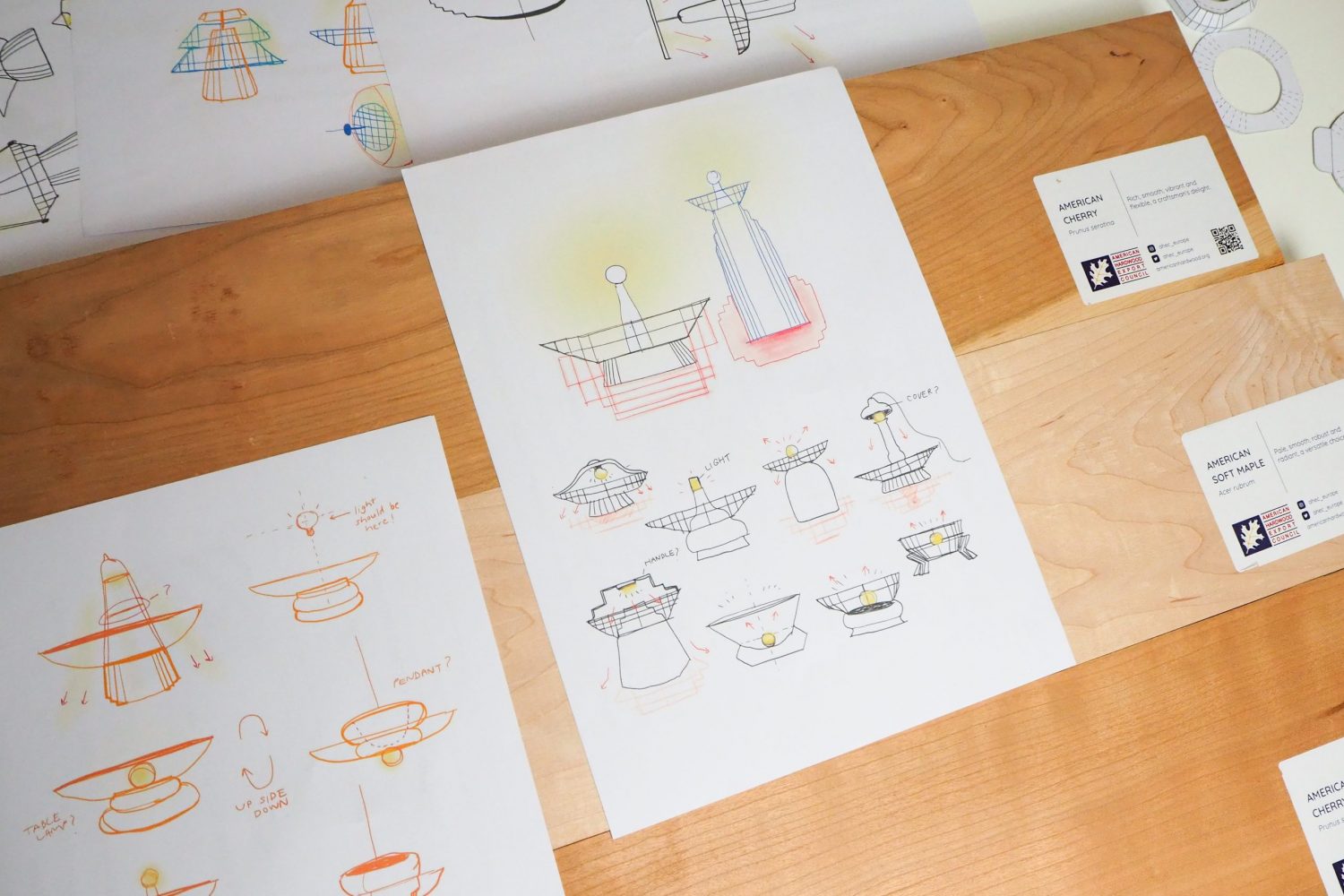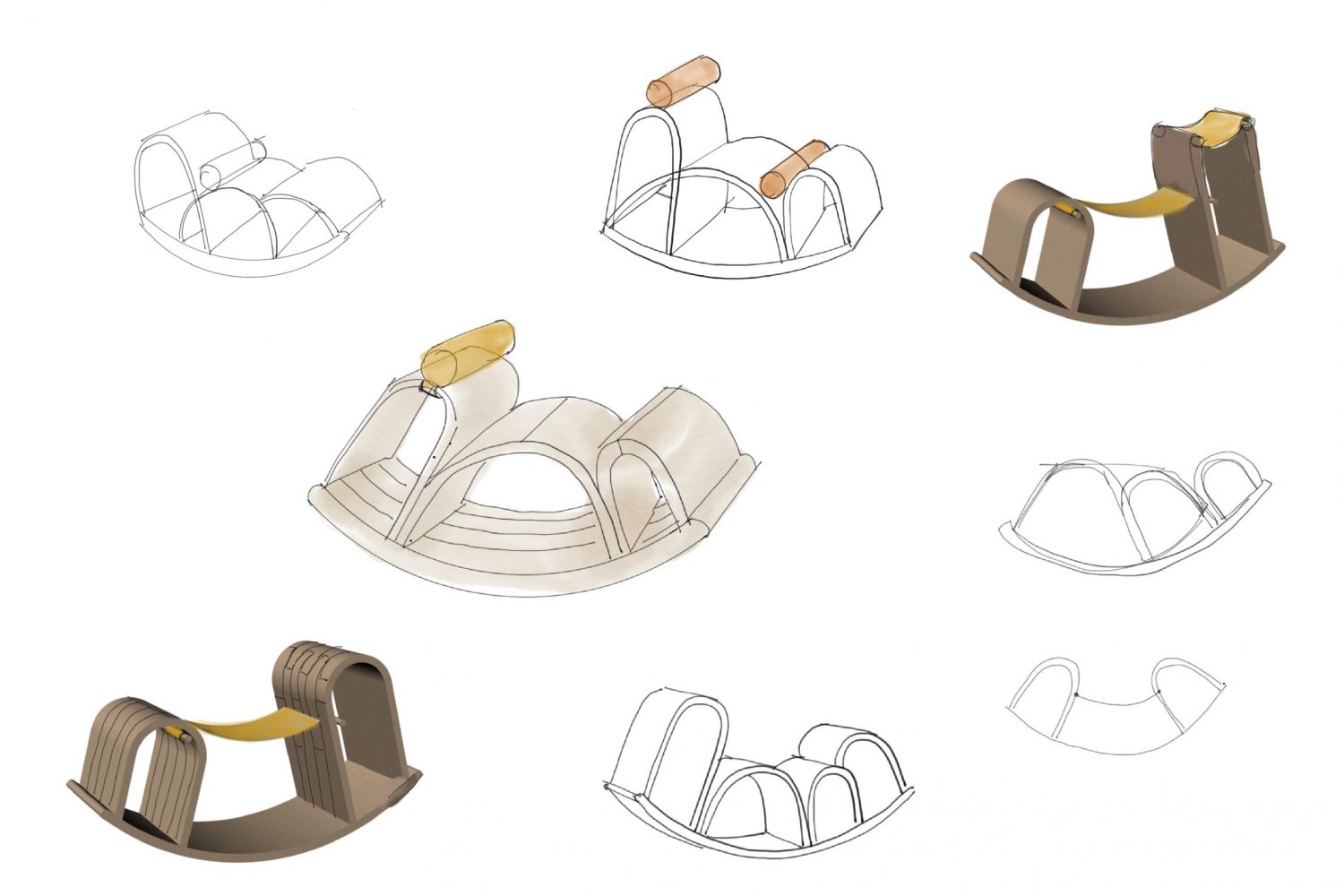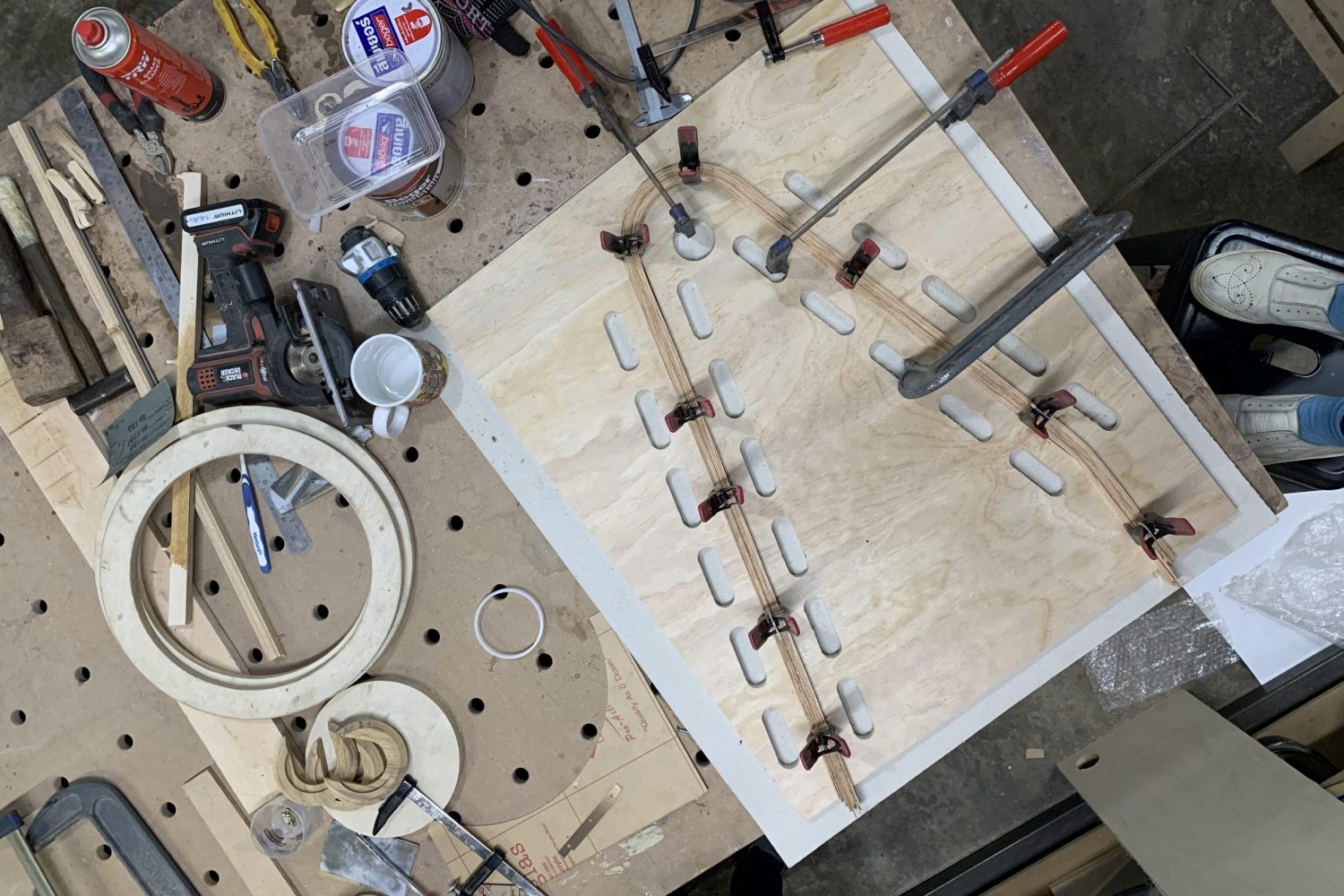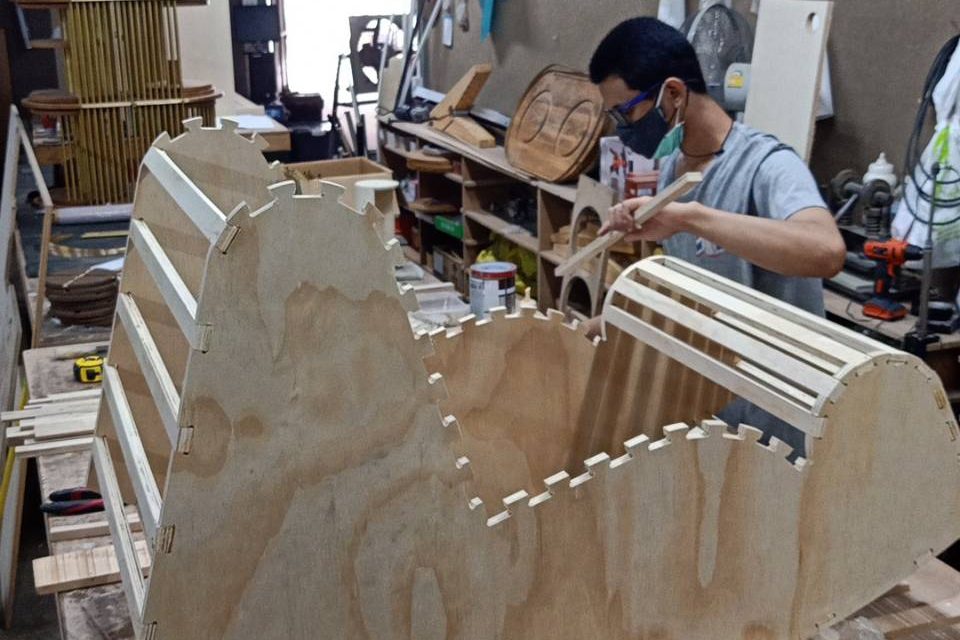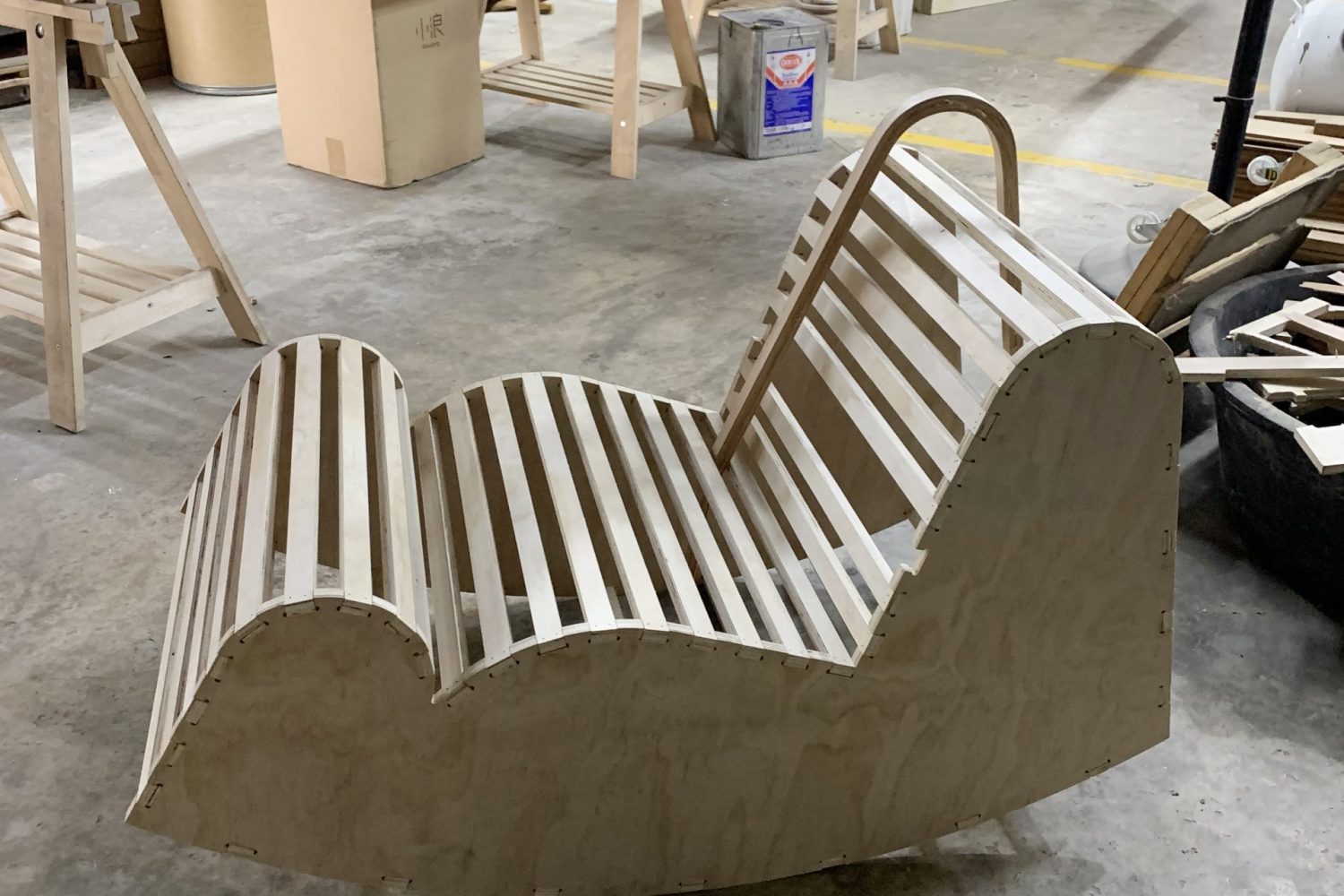ART4D SPEAKS WITH KAMONWAN MUNGATEE AND KORNPETCH CHOTIPATOOMWAN, TWO RISING THAI DESIGNERS WHOSE PROJECTS ARE SHOWCASED AT THE DESIGN MUSEUM, LONDON AS A PART OF AHEC’S ‘DISCOVERED’ PLATFORM
TEXT: PRATARN TEERATADA
PHOTO COURTESY OF AHEC EXCEPT AS NOTED
(For Thai, press here)
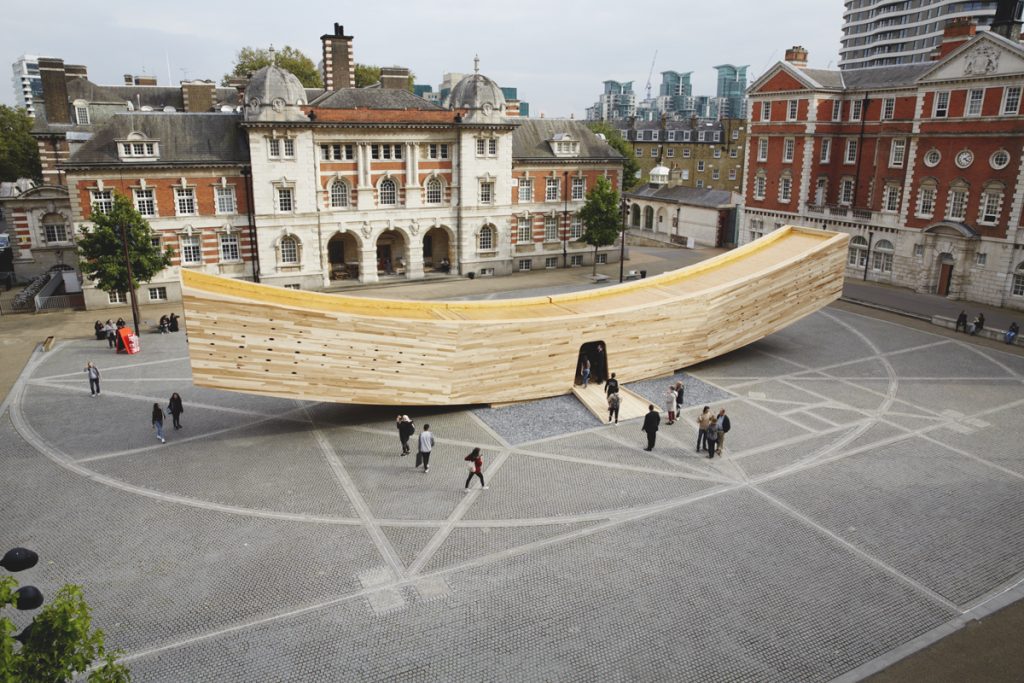
The Smile, collaborative project between London Design Festival, Alison Brooks Architects, AHEC and Arup as an exhibition space inside London Design Festival 2016 | Photo courtesy of Dav Stewart and Jon Cardwell
American Hardwood Export Council (AHEC) is a highly influential marketing organization and supporter of the creative approaches to new developments in the hardwood industry. In the past several years, AHEC has invited both budding and globally renowned designers to collaborate in thought-provoking and creatively challenging projects. Their collaborations with London Design Festival have been particularly exciting with works such as Sclera, the circular wooden pavilion that they co-developed with David Adjaye in 2008, or The Wish List, the 2014 project that paired up legendary designers to up-and-coming design talents for a handful of innovative products. The 2016 collaboration invited architect Alison Brooks and the engineering team from Arup to create a large-scale structure made of sizeable wooden tubes. Each project is memorable and inspiring in its own way, and all have garnered recognition worldwide.
AHEC has now joined forces with Wallpaper* magazine for their first global design collaboration. Named “Discovered,” 20 rising designers from 16 countries have been invited to develop prototype products from three different types of American hardwood: red oak, maple and cherry, drawing on the personal experiences they have gained during the pandemic. All the works are scheduled to showcase at the Design Museum in London later this year. It’s also worth mentioning that among the selected 20 designers are two Thai designers, Kamonwan Mungnatee (Mew) and Kornpetch Chotipatoomwan (Nong).

Kamonwan Mungnatee (Mew)
In 2019 Kamonwan founded Budd Design Studio in Bangkok. She’s an industrial design graduate from King Mongkut’s Institute of Technology Ladkrabang’s Faculty of Architecture and established her studio on the same year she finished school. Ranging from home decoration items to furniture, her works take inspiration from people’s surrounding contexts and everyday-life objects, with a particular focus and thought process that revolves around creativity, specifically from the aspects of material, technicality and form. For the ‘Discovered’ project, Kamonwan has designed the Corners Lamp inspired from Thai ancient Chedi (a Buddhist stupa) by incorporating her personal emotional experiences the result is an interesting connection between form, light and shadow.

Kornpetch Chotipatoomwan (Nong)
Kornpetch, another Thai designer selected for the project, is driven to bring a new standard to everyday life objects and user experiences. Kornpetch stands out with the design ethos expressed through unique shapes that resonate with users’ new experiences and lifestyles. She is a RISD (Rhode Island School of Design) and RCA (Royal College of Art) alumni whose interest lies in the amalgamation of fashion, furniture, lighting and space design. Her graduation project titled “Landing Space” was one of the works on Sight Unseen’s 2017’s Talents to Watch List.
‘Thought Bubble,’ the work she is developing for Discovered, originated from human beings’ past familiarity with travel and social behaviors and presents itself as a rocking chair that offers a sense of tranquility and a meditative state of mind through its slow, steady rhythm.
art4d shares with you our brief conversations with the up-and-coming designers about their ideas and experiences participating in the project.
How did you feel to be one of only 20 designers globally to participate in this project
Kamolwan Mungnatee (Mew): I was very excited about this project and thought it was very interesting right away. Such as being exhibited at the London Design Museum and Wallpaper * It is unquestionably a dream area for Thai designers like myself to be able to design and showcase our work there. They are well-known in the global design industry. As a Thai designer, it sets a new standard of work for me and is a great opportunity to prove myself in a larger international context.
Kornpetch Chotipatoomwan (Nong): I feel incredibly fortunate to be selected. This project has given me a rare opportunity to work with experts from all over the world and to collaborate with global publishers and companies such as Wallpaper and AHEC. Additionally, I genuinely value the opportunity to exhibit my work at the Design Museum in London, which holds a very special place in my heart. The museum is home to many inspiring pieces from designers that I admire, and I am extremely honored that I am able to show my work here, where I discovered many of my inspirations.
art4d: What is your inspiration and core concept behind your design?
KM: The inspiration comes from a construction detail in traditional Thai architecture called ‘Yor Moom’ or indented corners. It’s a technique widely used by Thai builders and craftsmen to create decorative elements for rectangular structures. The method creates multiple recessed corners to the structure’s exterior, and simultaneously, these corners appear as vertical, three-dimensional details within the interior space.
I want to reflect these structural attributes using the technique by reinterpreting into the work’s different, unique design characteristics. When the light casts on a chedi, it creates incredible interactions between the architectural structure and light and shadow. I find that to be very interesting and seek to re-visualize the effects through different perspectives from which light and shadow interact. The lighting collections are conceived from the intention for the reflected light on the surface to render a new visual created by the reinterpretation of recessed corners, ultimately curating an atmospheric experience from the interactions between the piece and the space it occupies.
KC: The design is a response to the blurred line between personal life and work brought about by the pandemic. The core concept behind my design is how ordinary objects that we touch help us to reflect on ourselves and to form the foundation of our personal strength. Specifically, I am exploring the calming effect that rocking motion has on us; how it activates our ability to project our awareness inwards to soothe and help us find our own thoughts amid our hectic schedules.
During the pandemic, we are spending more time than ever at home. We are using our homes not only to eat, sleep and rest, but also to work, exercise, and teach. For many people, this new routine has brought about profound mental stress and a deep yearning for social connection. To make up for the lack of connectivity, many have turned to social media or picking up new hobbies. In my opinion, I see these behaviors as a temporary solution to the boredom brought about by being stuck at home. While we often look outwards to find mental and emotional support, I believe that looking inward to gain self-awareness is the true foundation of emotional well-being.
art4d: What have you learnt from the project’s mentor Nathan Yong?
KM: Nathan Yong is a very talented designer, so working with him has been an incredible experience. He’s very open. He always asked questions about different aspects of the design but didn’t try to oppose but rather constructively reinforced and challenged my ideas, which was great because that really helped me reflect all these thoughts I had in my head. I was able to process all these different methods to create new possibilities and connect all these dots between the concept, materials and production so that everything would work well together and deliver what I had envisioned.
KC: During the design process, Nathan has always been the voice that helps keep the project grounded and the design within the manufacturer’s capabilities. He often made useful suggestions to help take advantage of the characteristics of the hardwoods we were given to use in our designs.
What have you learnt about the material that was at the centre of this project?
KM: I was excited receiving diverse samples of timber, which included American cherry, hard and soft maple and red oak. I saw all three species of timber with different characters and they looked fantastic. I feel that timber is always interesting to me because it is always alive, has different properties for each type, has its timeless value. It is therefore worth learning and working with it. They are simply wonderful materials for furniture and product design. Hardwoods also have many different species and the grain of each piece has a uniqueness to it, like a fingerprint where you would never have similar patterns all the time. From the concept I want to create, it is about the vision of light and shadow. When I touched and pondered the timber specimens. I found that the cherry and the soft maple were special when the light hit the timber so I chose these two species of timber due to their properties suiting the method of construction to my design.
KC: Through this project, I developed a much deeper understanding and appreciation for hardwoods. At the start of this project, we were sent samples of different types of timber to examine: American cherry, hard and soft maple and red oak. I was able to learn about the capabilities of each type of timber as well as their environmental impacts. The timber I’ve chosen to work with was American red oak, which has beautiful distinctive grains suitable for steam bending. They are hard and stable when dried, which provides essential strength for the curvature in my design. Additionally, the porous nature of the red oak that enables it to draw stains through its grain and create patterns that is unique to the species fascinates me.
As a designer who grew up in Bangkok, where air pollution is a concern, I appreciate the data provided by AHEC to raise awareness for designers today to also consider the environmental impact of the material selected beyond their physical properties. Data from the Forest Inventory and Analysis (FIA) indicates that American red oak’s growth rate exceeds harvest resulting in a net increase of 28.7 million m³ of American red oak volume per year; making American red oak a sustainable choice of material.
art4d: What are the challenges you faced in participating in this project?
KM: I tried to think about the final result I had intended for the work and the techniques that would be applied to the American cherry because the design had to be handed over to the manufacturer to produce. Design is about compatibility, but it’s also about precision because, for every production, there’s complexity. Each manufacturer has their own expertise. So I needed to communicate as best as I could with the manufacturer to achieve the desired outcome.
KC: The toughest challenge I faced in participating in this project was the distance and the lack of direct contact between the manufacturer and myself brought about by the travel restrictions. The lack of contact made it challenging to collaborate with the manufacturers and test out different construction techniques together. However, the manufacturer, Fowseng, are world class and so I had trust in their ability and expertise.
art4d: What are your next moves after ‘Discovered’?
KM: This project has enabled me to see how design can be adapted to different situations. And it wasn’t only about adaptation. I took this chance to try and experiment with new ideas. After this project, I will continue to do what I do and explore new opportunities and possibilities. I want to create more works amidst ongoing and future challenges and find ways for my design to further develop and grow.
KC: At the end of last year, I moved back to Bangkok after working as a designer for two and a half years. This year, I have been working for my family’s packaging business while concurrently working on my own projects that I hope to share next year. Please stay tuned and follow my progress on Instagram: nong_kornpetch.


